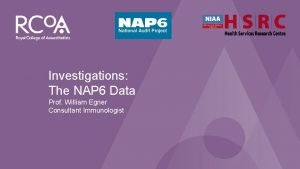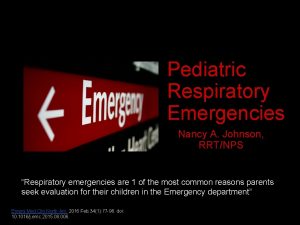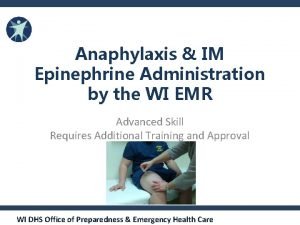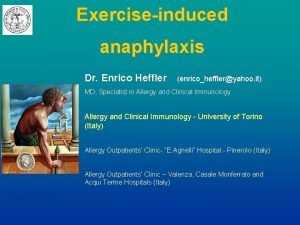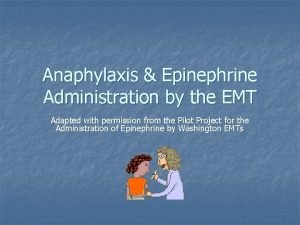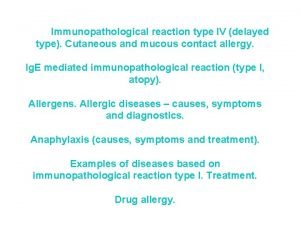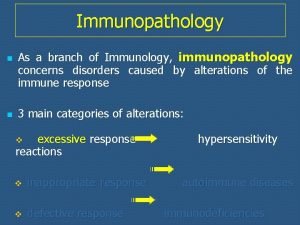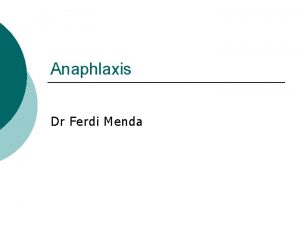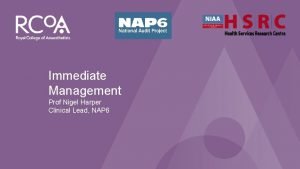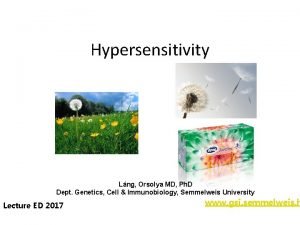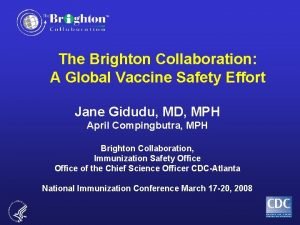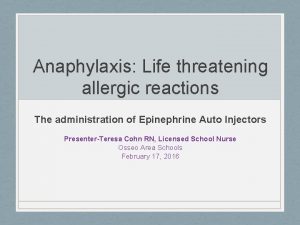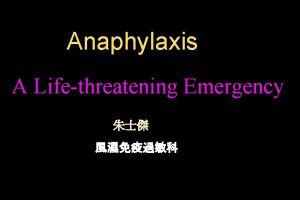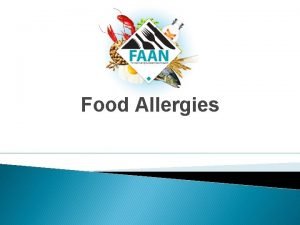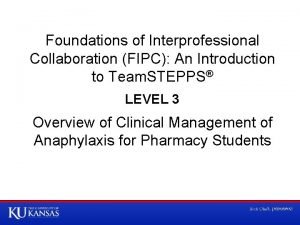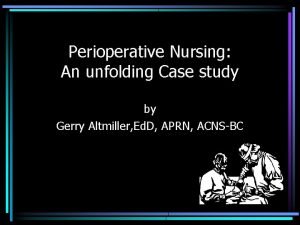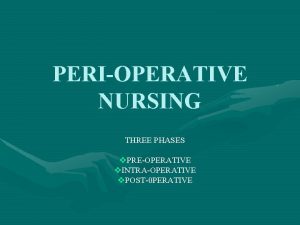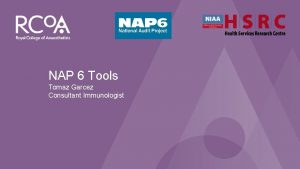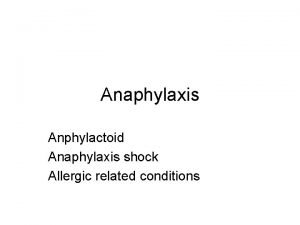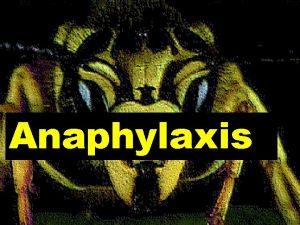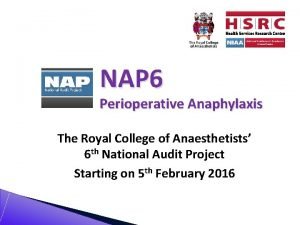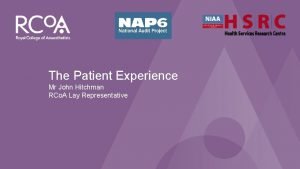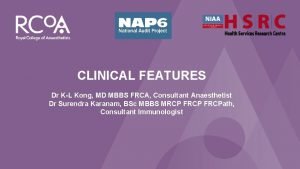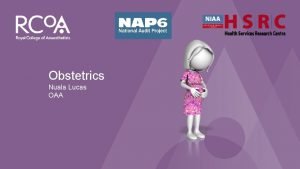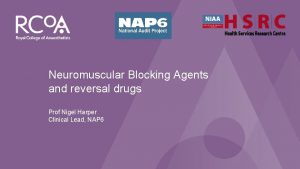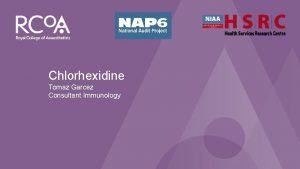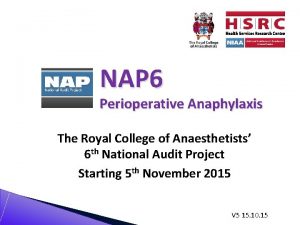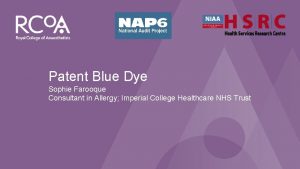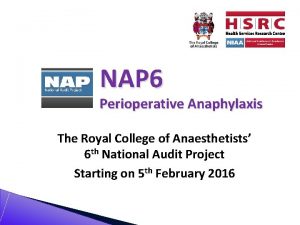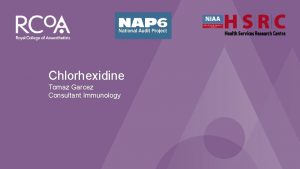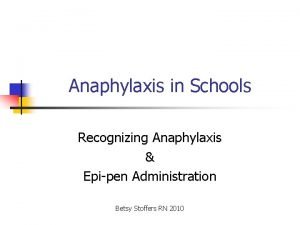NAP 6 Perioperative Anaphylaxis NAP 6 the independentprivate





















- Slides: 21

NAP 6: Perioperative Anaphylaxis NAP 6 – the independent/private sector m Tim Cook Director of NAP program Consultant Anaesthesia/Intensive Care, Bath

NAP 6: Perioperative Anaphylaxis Chapter 23 – The independent sector

NAP 6: Perioperative Anaphylaxis What we know already • 45% of independent sector patients are NHS-funded (CHPI 2017) – >50% in 25% of private hospitals) • Orthopaedics is 25% of private surgery (CMA 2014) – 1 in 5 of all NHS hip and knee replacements (Nuffield trust 2015) • Smaller, isolated, competitive • Lack of departmental structure in many private hospitals • Lone wolf anaesthetists vs anaesthetic group practices

NAP 6: Perioperative Anaphylaxis Efforts • No previous NAP included independent sector • Private hospitals identified – – List provided by Association of Independent Healthcare Organisations based on Lang & Buisson data • Written to x 4 – RCo. A president – May 2015, June 2015, Sept 2015, Dec 2015 • Deadlines delayed x 3

NAP 6: Perioperative Anaphylaxis Barriers to engagement

NAP 6: Perioperative Anaphylaxis Numbers • 304 hospitals contacted • 41 agreed to take part (13% vs 100%) • 33 took part in organisational survey (11% vs 91%) DECISION Independent sector not included for main data collection quantitative analysis No baseline survey, no activity survey

NAP 6: Perioperative Anaphylaxis Numbers Organisational comparison

NAP 6: Perioperative Anaphylaxis Numbers Organisational comparison

NAP 6: Perioperative Anaphylaxis Case reporting - involvement NHS Hospitals All monthly returns Overall return rate Independent sector 356 (100%) 41 (13%) 84% 39% 94% 70%

NAP 6: Perioperative Anaphylaxis Cases in independent sector • 7 requests to report – 2 complete, – 5 part A only

NAP 6: Perioperative Anaphylaxis Of the 7 cases • • • 4 aged 66 -77 5 orthopaedics All ASA 2 -3 5 had antibiotics 4 had NMBAs Grades – 4 grade 4 (<50 mm. Hg) – 3 grade 3

NAP 6: Perioperative Anaphylaxis Of the 7 cases • 3 used anaphylaxis pack • 6 used guidelines • 5 did not call for assistance – 1 nursing staff – 1 an other anaesthetist • 0 - CPR for BP <50 mm. Hg • Surgery – 2 completed – 1 modified – 4 abandoned • 3 to ICU – 1 on site – 2 another hospital • All referred • None reported to MHRA

NAP 6: Perioperative Anaphylaxis Comment • Anaphylaxis is – Unpredictable – Life-threatening – Infrequent …. but predictable enough to require preparation Independent sector patients are likely to be exposed to top three culprits (antibiotics, NMBAs, chlorhexidine)

NAP 6: Perioperative Anaphylaxis Comment • Anaphylaxis treatment requires – expert, timely, co-ordinated resuscitation – teamworking – typically needs critical care for up to 48 hours – referral for investigation and follow-up – reporting

NAP 6: Perioperative Anaphylaxis Challenges for the independent sector • Engagement • Governance – – Ensuring training Communication by organisation Teamworking Lack of Anaesthetic departments • Protocols and SOPs • M&M – Crisis management experience

NAP 6: Perioperative Anaphylaxis Challenges for the independent sector • Engagement • Governance – – Ensuring training Communication by organisation Teamworking Anaesthetic departments • Protocols and SOPs • M&M – Crisis management experience • Drugs – Vasopressors – Glucagon – Vasopressin • • Critical care Transfer Referral Reporting and follow-up

NAP 6: Perioperative Anaphylaxis Recommendations

NAP 6: Perioperative Anaphylaxis Recommendations

NAP 6: Perioperative Anaphylaxis Recommendations

NAP 6: Perioperative Anaphylaxis Recommendations

NAP 6: Perioperative Anaphylaxis Summary • • First attempt to engage independent sector Poor engagement Inevitable that anaphylaxis will occur in independent sector NAP 6 has been unable to characterise how those cases are typically managed • NAP 6 has identified significant challenges for independent sector for ensuring safety in this (and other) critical situations.
 Nap anaphylaxis
Nap anaphylaxis Epiglotitis
Epiglotitis How to draw up epinephrine
How to draw up epinephrine Anaphylaxis
Anaphylaxis How to draw up epi from an ampule
How to draw up epi from an ampule Anaphylaxis grade
Anaphylaxis grade Anaphylaxis images
Anaphylaxis images Triptase test
Triptase test Angioedema anaphylaxis
Angioedema anaphylaxis Nap 6 recommendations
Nap 6 recommendations Anaphylatoxins
Anaphylatoxins Brighton collaboration criteria
Brighton collaboration criteria Allergist delta dental
Allergist delta dental Anaphylaxis photos
Anaphylaxis photos Anaphylaxis treatment
Anaphylaxis treatment Anaphylaxis onset
Anaphylaxis onset Ig
Ig Interprofessional care for anaphylaxis
Interprofessional care for anaphylaxis Anaphylactoid vs anaphylaxis
Anaphylactoid vs anaphylaxis Perioperative case study nursing
Perioperative case study nursing Ccs perioperative guidelines
Ccs perioperative guidelines Perioperative vs preoperative
Perioperative vs preoperative
